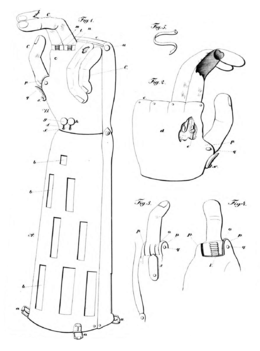Altruppin hand

The Altruppiner hand is a passive, left hand prosthesis from the early 16th century. Theodor Fontane referred to the prosthesis in his book Walks through the Mark Brandenburg as "Götz-Hand". It is exhibited as an exhibit in the Museum Neuruppin .
Find and dating
The Altruppiner hand was in the navigability of the river Rhin in August 1834 (by Theodor Fontane in February 1836) near a bridge in Alt Ruppin found. Were also found spurs , stirrups and a sword , after which Hermann Fritze 1842 dated the craft in the 15th century.
After comparing it with other Iron Hands, the prosthesis comes from the early 16th century, more precisely from the time before 1528. It would have been made during the same period as the lesser-known “first hand” by Götz von Berlichingen .
construction
The hand prosthesis from Alt Ruppin is a typical iron hand from the Renaissance period . The prosthesis is made of sheet iron and, like the Iron Hand in the Hessian State Museum in Darmstadt, has a long arm cuff that is windowed to reduce weight , but the weight of the prosthesis is around 1.4 kg. The fingers are artistically executed, they show well-formed fingernails and wrinkles. Presumably the hand was originally painted in the color of flesh .
The mechanism of the handicraft is similar to the first Götzhand. As with most other artificial hands of the time, two fingers are combined into a block, which are arranged on a common axis. The two blocks can be bent inwards individually with a healthy hand or by propping up on them; they are locked in place by pawls , similar to a battery lock . By pressing one of the buttons on the inside of the wrist, the corresponding finger block jumps back into the open starting position ( extension ) by spring force - in contrast to many other iron hands, both finger blocks can be stretched individually with the Altruppiner hand. The thumb is movable in the base joint and can be operated independently of the finger blocks.
Fontane reports that the mechanism was partially exposed due to corrosion , but was still functional.
literature
- Hermann Eduard Fritze, Carl Alexander Ferdinand Kluge: Arthroplasty. All the artificial hands and feet that have hitherto become known to replace these lost limbs. Meyer, Lemgo 1842 in the Google book search.
- Theodor Fontane: Walks through the Mark Brandenburg. First part: The County of Ruppin . Third increased edition, Hertz, Berlin 1875 ( for Project Gutenberg ).
- Liebhard Löffler: The replacement for the upper extremity. The development from the first certificates until today. Enke, Stuttgart 1984, ISBN 3-432-94591-4 .
Web links
- Museum Neuruppin (with photo of the Altruppiner hand)
Individual evidence
- ↑ a b Martin Friedrich Karpa: The history of the arm prosthesis with special consideration of the performance of Ferdinand Sauerbruch (1875–1951). Bochum 2004, p. 19 f. ( Digitized version ).
- ^ A b c Theodor Fontane: Walks through the Mark Brandenburg. P. 122 f.
- ^ Museum Neuruppin , as seen on June 7, 2020
- ↑ a b c d Hermann Fritze: Arthroplasty. P. 123 ff.
- ↑ a b c d Liebhard Löffler: The substitute for the upper extremity. P. 27 ff.
- ↑ a b Günter Quasigroch: The prosthetic hands of the Frankish kingdom knight Götz von Berlichingen. 1. Continuation: The first hand. In: weapons and costume studies. Vol. 24, 1982, pp. 17-33.